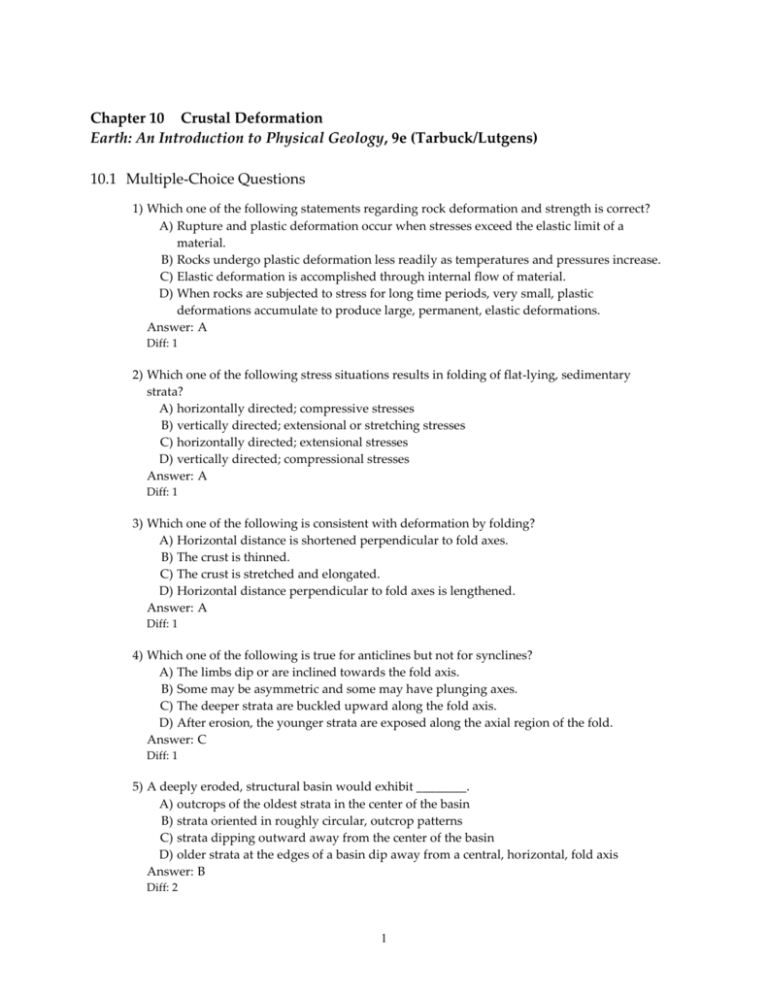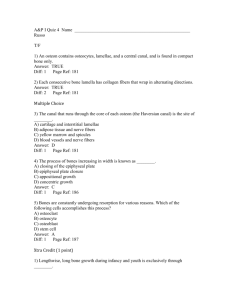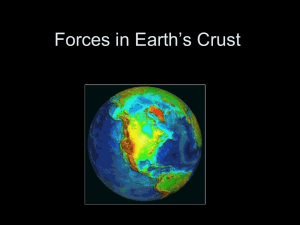Earth,Tests,Ch10
advertisement

Chapter 10 Crustal Deformation Earth: An Introduction to Physical Geology, 9e (Tarbuck/Lutgens) 10.1 Multiple-Choice Questions 1) Which one of the following statements regarding rock deformation and strength is correct? A) Rupture and plastic deformation occur when stresses exceed the elastic limit of a material. B) Rocks undergo plastic deformation less readily as temperatures and pressures increase. C) Elastic deformation is accomplished through internal flow of material. D) When rocks are subjected to stress for long time periods, very small, plastic deformations accumulate to produce large, permanent, elastic deformations. Answer: A Diff: 1 2) Which one of the following stress situations results in folding of flat-lying, sedimentary strata? A) horizontally directed; compressive stresses B) vertically directed; extensional or stretching stresses C) horizontally directed; extensional stresses D) vertically directed; compressional stresses Answer: A Diff: 1 3) Which one of the following is consistent with deformation by folding? A) Horizontal distance is shortened perpendicular to fold axes. B) The crust is thinned. C) The crust is stretched and elongated. D) Horizontal distance perpendicular to fold axes is lengthened. Answer: A Diff: 1 4) Which one of the following is true for anticlines but not for synclines? A) The limbs dip or are inclined towards the fold axis. B) Some may be asymmetric and some may have plunging axes. C) The deeper strata are buckled upward along the fold axis. D) After erosion, the younger strata are exposed along the axial region of the fold. Answer: C Diff: 1 5) A deeply eroded, structural basin would exhibit ________. A) outcrops of the oldest strata in the center of the basin B) strata oriented in roughly circular, outcrop patterns C) strata dipping outward away from the center of the basin D) older strata at the edges of a basin dip away from a central, horizontal, fold axis Answer: B Diff: 2 1 6) A ________ fault has little or no vertical movements of the two blocks. A) stick slip B) oblique slip C) strike slip D) dip slip Answer: C Diff: 1 7) In a ________ fault, the hanging wall block move up with respect to the footwall block. A) normal B) inverse C) reverse D) abnormal Answer: B Diff: 1 8) In thrust faulting, ________. A) grabens develop on the footwall block B) the crust is shortened and thickened C) horizontal, tensional stresses drive the deformation D) the hanging wall block slips downward along the thrust fault Answer: B Diff: 1 9) Which one of the following would not be a characteristic of the San Andreas fault zone? A) steep, near vertical, dip-slip, fault scarps B) sag ponds C) deformed, broken, and pulverized bedrock D) laterally offset stream channels Answer: A Diff: 1 10) A graben is characterized by ________. A) a hanging wall block that has moved up between two reverse faults B) a footwall block that has moved up between two normal faults C) a hanging wall block that has moved down between two normal faults D) a footwall block that has moved down between two reverse faults Answer: C Diff: 1 11) The mountains and valleys of the Basin and Range Province of the western United States formed in response to ________. A) strike-slip faulting and hanging wall block uplifts B) reverse faults and large displacement, thrust faulting C) tensional stresses and normal-fault movements D) normal faulting and horizontal compression Answer: C Diff: 1 2 12) The Navajo and Dakota Sandstones are ________. A) marine limestone formations in the central Appalachian region B) Mesozoic, sedimentary rock formations in Utah, Colorado, and neighboring states C) prominent, lower Paleozoic strata in the British Isles and northern France D) quartz-rich, granite batholiths in the Sierra Nevada range, California Answer: B Diff: 1 13) A ________ is a defined, recognizable, mappable, rock unit with a known age. A) strata set B) lithologic sequence C) formation D) stratigraphic section Answer: C Diff: 1 14) In a normal fault ________. A) the hanging wall block below an inclined fault plane moves downward relative to the other block B) the footwall block below an inclined fault plane moves downward relative to the other block C) the hanging wall block above an inclined fault plane moves downward relative to the other block D) the footwall block above an inclined fault plane moves upward relative to the other block Answer: C Diff: 1 15) A reverse fault is one in which ________. A) the hanging wall block has moved up relative to the footwall block along an inclined fault B) the block above the fault plane has moved backwards with respect to the other block C) one block has moved downward and the other moved horizontally along a vertical fault D) both blocks have moved horizontally in opposite directions along an inclined fault Answer: A Diff: 1 16) Jointing in rocks is characterized by ________. A) closely spaced, parallel faults along which the blocks have moved in opposite directions B) structures formed where normal and reverse faults intersect C) the hinge lines connecting two limbs of an anticline or syncline D) roughly parallel fractures separating blocks that show no displacement Answer: D Diff: 1 3 17) ________ are the products of horizontally directed, tensional stresses. A) Normal faults B) Crustal thickening C) Reverse faults D) Thrust faults Answer: A Diff: 1 18) ________ in layered sedimentary rocks are evidence for horizontal compression and shortening. A) Normal faults B) Strike-slip faults C) Horsts and grabens D) Tight folds Answer: D Diff: 1 19) A transform fault is ________. A) a strike-slip fault that forms the boundary between tectonic plates B) a dip-slip fault connecting an anticline with a syncline C) a reverse fault that steepens into a thrust fault D) the rift bounding faults on a mid-ocean ridge Answer: A Diff: 1 20) The ________ in California is the boundary between the North American and Pacific plates. A) Sierra Nevada frontal fault B) San Andreas strike-slip fault C) San Luis Obispo thrust fault D) San Francisco normal fault Answer: B Diff: 1 21) Brittle deformation would be favored over plastic deformation in which of the following conditions? A) high confining pressures B) warmer temperatures C) cooler temperatures D) shallow depths Answer: C Diff: 2 22) A thrust fault is best described as ________. A) a steeply inclined, oblique-slip fault B) a low-angle, reverse fault C) a vertical, normal fault D) a near vertical, strike-slip fault Answer: B Diff: 1 4 23) A ________ is a prominent ridge formed by differential erosion of tilted, alternating hard and soft strata. A) mesa B) wadi C) hogback D) scarp face Answer: C Diff: 1 24) A horst is ________. A) an uplifted block bounded by two normal faults B) a downdropped block bounded by two reverse faults C) an uplifted block bounded by two reverse faults D) a downdropped block bounded by two normal faults Answer: A Diff: 1 25) Which one of the following best describes the geology of the Black Hills region in South Dakota? A) an eroded syncline with older, sedimentary strata in the axial region and younger, metamorphic rocks around the margins B) a basin filled with folded, sedimentary rocks and thick coal beds C) a large graben deeply eroded by Pleistocene glaciers D) an elongate dome cored by Proterozoic igneous and metamorphic rocks Answer: D Diff: 1 26) The Great Rift Valley of East Africa is characterized by ________. A) mainly thrust faulting as Africa collides with Arabia B) mainly anticlinal and synclinal folding as Africa collides with Madagascar C) mainly normal faulting as East Africa begins to fragment D) mainly transform faulting along zones connecting the rift with the Red Sea Answer: C Diff: 1 27) The Michigan geologic map shows older, Paleozoic strata (in roughly circular patterns) surrounding a core area of Pennsylvanian rocks. What is this structure? A) dome B) recumbent horst C) anticline D) basin Answer: D Diff: 2 5 28) Normal and reverse faults are characterized mainly by ________. A) strike slip B) horizontal slip C) dip slip D) basal slip Answer: C Diff: 1 29) A syncline is ________. A) a fold in which the strata dip away from the axis B) a fold with only one limb C) a fold in which the strata dip toward the axis D) a fold characterized by recumbent limbs Answer: C Diff: 1 10.2 Word Analysis Questions Examine the words and/or phrases for each question below and determine the relationship among the majority of words/phrases. Choose the option which does not fit the pattern. 1) A) compression B) strain C) tension D) shear Answer: strain Diff: 1 2) A) elastic Answer: compression B) ductile C) folding D) compression B) limb C) hinge D) axial plane B) anticline C) monocline D) basin C) thrust fault D) strike-slip fault Diff: 1 3) A) plunge Answer: plunge Diff: 2 4) A) dome Answer: monocline Diff: 2 5) A) normal fault B) reverse fault Answer: strike-slip fault Diff: 1 10.3 True/False Questions 1) Normal faults form in response to horizontal, tensional stresses that stretch or elongate the rocks. Answer: TRUE Diff: 1 2) In a reverse fault, the hanging wall block moves up relative to the footwall block. Answer: TRUE Diff: 1 6 3) The oldest, sedimentary rock strata are exposed along the axial parts of deeply eroded anticlines. Answer: TRUE Diff: 1 4) Horizontal, compressive deformation involves shortening and thickening of the crust. Answer: TRUE Diff: 1 5) Along oblique-slip faults, both blocks have horizontal and vertical components of movement. Answer: TRUE Diff: 1 6) Basin and range topography, like that in the western and southwestern United States, indicates that compressive folding is active today or was active very recently, geologically speaking. Answer: FALSE Diff: 1 7) Plastic deformation occurs more readily in warm rock than in cool rock. Answer: TRUE Diff: 1 8) A graben is an upraised block bounded by two reverse faults. Answer: FALSE Diff: 1 9) Fractures in rock that have not involved any fault slippage are called joints. Answer: TRUE Diff: 1 10.4 Short Answer Questions 1) The word ________ is used to describe movement on faults. Answer: slip Diff: 1 2) Does the hanging wall block move up or down along a reverse fault? Answer: up Diff: 1 3) Are horsts and grabens bounded by normal or reverse faults? Answer: normal Diff: 1 4) A(n) ________ has the strata on both limbs dipping away (outward from) the axis. Answer: anticline Diff: 1 7 5) A(n) ________ has strata on both limbs dipping inward toward the axis. Answer: syncline Diff: 1 6) A circular to elliptical structure developed by upward arching of the central strata is a ________. Answer: dome Diff: 1 7) A circular to elliptical structure developed by downwarping of the central strata is a ________. Answer: basin Diff: 1 8) ________ are fractures showing little or no movement of the rocks on either side. Answer: Joints Diff: 1 9) In a thrust fault, the hanging wall moves ________ relative to the footwall and the fault plane is oriented at a ________ angle. Answer: up; low Diff: 1 10) ________ fault develops in response to horizontal, tensional stresses in crustal rocks. Answer: Normal Diff: 1 10.5 Critical Thinking Questions Use complete sentences, correct spelling, and the information presented in Chapter 10 to answer the questions below 1) A fault is observed in a road cut, but there are no obvious rocks units to correlate on either side of the fault to determine relative movement. How else might you determine or even infer whether the hanging wall has moved up or down relative to the footwall? (Hint: Think of fossils, tectonic setting, etc.) Diff: 2 2) The words "dome" and "basin" also refers to topographic features as well as geologic structures. Would a geologic dome (or basin) necessarily be expressed topographically as the same form on Earth's surface (for example would a geologic dome always be a topographic uplift)? Why or why not? Explain your answer. Diff: 3 3) A region is characterized by numerous anticlines and synclines. There are also several faults present that appear to have formed at the same time as the folding. Without looking at any details, what type of faults would you assume them to be? Why? Diff: 2 8 10.6 Visualization Questions 1) Carefully study each illustration below to determine the type(s) of geologic structure(s) it contains. Match each one to the correct answers listed. A) reverse fault B) monocline a) ________ b) ________ c) ________ Answer: a) C b) A c) B Diff: 1 9 C) normal fault 2) On the blanks provided below, fill in the name of the specific type of geologic feature that have been labeled. Answer: a) graben b) horst c) normal faults Diff: 1 3) What kind of geologic structure is present in the photograph below? a) ________ Explain your answer. b) ________ Answer: a) normal fault b) The hanging wall has moved down relative to the footwall. Diff: 2 10 4) What kind of geologic structure is present in the photograph below? a) ________ Explain your answer. b) ________ Answer: a) a recumbent fold b) The layers have been folded, and the fold is lying on its side. Diff: 2 5) On the blanks provided below, write the name of the specific feature that has been labeled. What kind of fold is this? d) ________ Answer: a) axial plane b) axis c) limbs d) anticline Diff: 2 11 6) Each of the block diagrams below portrays a specific kind of geologic structure. Write the name of the structure on the blank provided beside each block diagram. a) ________ b) ________ Answer: a) dome b) basin Diff: 1 12







